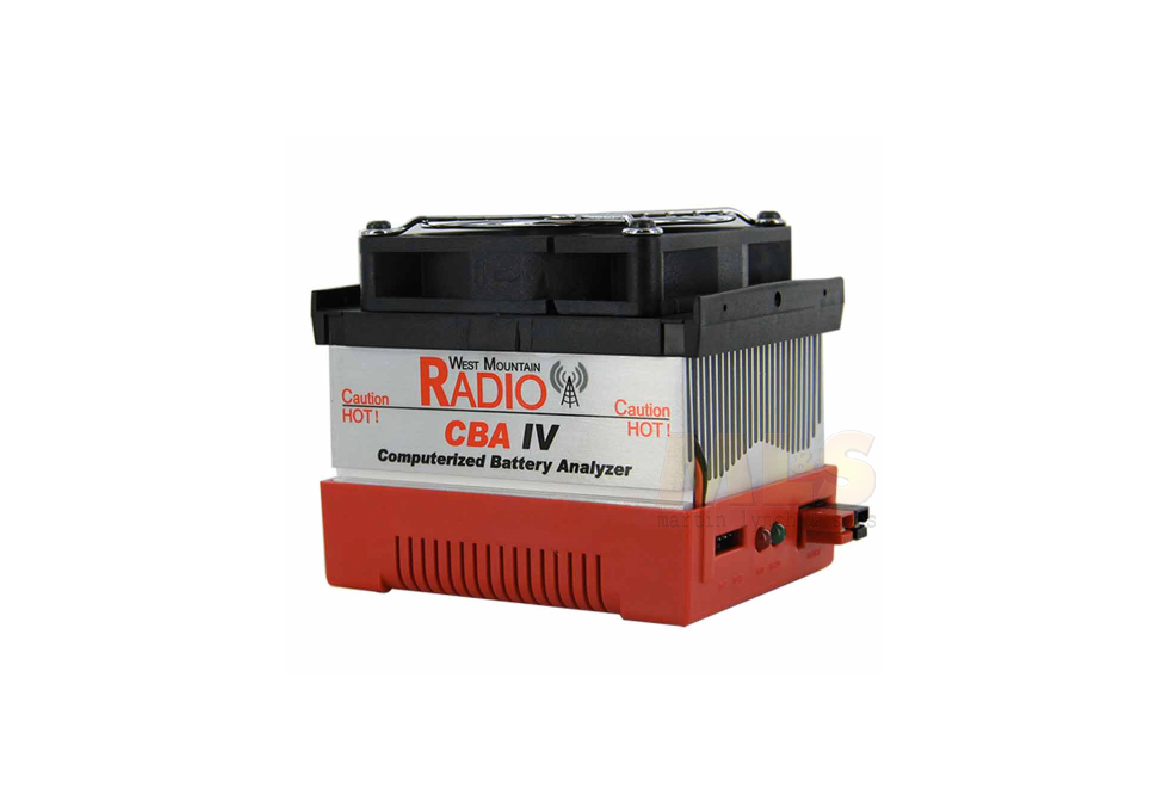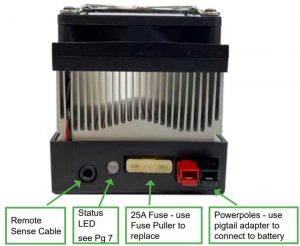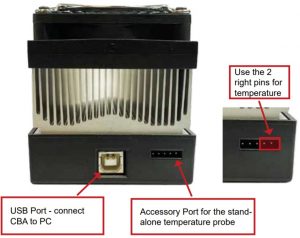West Mountain Radio 58250-1015 CBA Computerised Battery Analyser User Manual
Introduction
Thank you for choosing the West Mountain Radio CBA. It takes the guesswork out of using batteries and it will help you learn about batteries.The CBA is much more than a simple battery voltage tester or a battery load tester.The CBA will test virtually any type or size of battery, any chemistry or number of cells, with modest limits on voltage and discharge current. Now anyone can do scientific tests of their batteries for a reasonable price. The CBA V is capable of tests up to a maximum of either 40 ams at lower voltages or 150 watts continuous at higher voltages. When using an optional amplifier, tests can be done at 500 watts. Amplifiers can be used in parallel for higher power discharges.The CBA not only tests the total amount of energy stored in battery (capacity in amp-hours) but it graphically displays and charts the voltage versus time using a constant current load. Graphs may be displayed, saved and printed and the axis parameters can be changed at anytime. Multiple test graphs of the same battery, or multiple batteries, may be compared or overlaid; a very useful feature.The CBA is ruggedly built and supplied with 45 Amp Powerpole® connectors for the battery connection. It is small with a high performance cooling system and quiet fan. It is provided with LED indicators, visible from across a room, that display communication and test status.The software supplied with the CBA, is easy to use and intuitive. It provides automatic sensing of the battery cell count, a safety check of the test rate, and recommends a minimum safe discharge voltage. It is designed to protect both the CBA and the batteries being tested. Test profiles may be edited or recalled by the user.The optional Extended Software license provides all the features of the standard version, but adds a number of advanced features. The Extended Software version also adds the ability to graph the battery temperature with when the optional temp probe is connected.
Package Contents
The following is a list of the contents for the CBA IV. Verify that all the following items were included:
- CBA Computerized Battery Analyzer Unit
- USB Cable
- 6” Pigtail Adapter (Battery-to-CBA)
- Spare 25-Amp Fuse
- Fuse Puller
- Remote Sense Cable (supplied with Pro units only)
- CD of CBA Standard Software
- User’s Manual
Safety Precautions
The West Mountain Radio CBA is inherently safe but the batteries it tests are not. Anything that stores energy is potentially dangerous! Some types of batteries are safer than others but they are all capable of causing explosions or fires.For technical information on a battery, refer to the Battery Manufacturers website to get detailed information on the rating of the battery. Most battery labels have limited information, but the manufacturer’s website may have more detailed information.General Information on batteries is also available on the West Mountain Radio CD.
Primary Safety Considerations:
- Never discharge a battery at a higher discharge rate than it is designed for.
- Never use a battery that has poorly insulated or frayed wiring or exposed metal parts.
- Never connect a battery with reverse polarity.
- Never test a battery near flammable materials.
- Never allow a battery reach a temperature that causes it to get so hot that it may be too hot to touch, or battery case softens or fumes.
- Recharge the batteries immediately with an appropriate battery charger after the test is complete. Some types do not like to sit discharged for extended periods of time.
- Never test or charge your batteries while unattended.
- Have a fire extinguisher nearby.
- Never connect a battery with the polarity reversed!
- Always connect the USB cable BEFORE connecting the battery!
- Do not connect a battery to the CBA that is connected to something else unless an isolated USB hub is used.
- If using a USB HUB, make sure it is a powered hub. That means it will have a separate power connection to the hub so it can fully power the CBA.
- Operate the CBA in a cool dry location.
- Never allow fingers, metal parts or wiring of the battery come in contact with the metal heat sink.
- Never allow the cooling fan to be blocked or jammed.
- Do not ignore the warnings that the software may report.
- The CBA can get hot. Do not touch the metal heat sink while, or shortly after, conducting a high power test.
Liability Disclaimer
West Mountain Radio will not be liable (whether under the law of contract, the law of torts or otherwise) in relation to the contents of, or use of, or otherwise in connection with, the CBA (“product”):
- To the extent that the product may cause any bodily or equipment damage;
- For any indirect, special or consequential loss of any kind;
- For any business losses, loss of revenue, income, profits or anticipated savings, loss of contracts or business relationships, loss of reputation or goodwill, or loss or corruption of information or data.
By using this product, you agree to the limitations of liability set forth in this disclaimer are reasonable.
Lead Acid Battery Safety Warnings:These batteries, especially automotive and marine types, give off explosive hydrogen gas when charged. A nearby or internal spark or flame can cause a lead acid battery to explode sending liquid acid and lead shrapnel in all directions. This is particularly dangerous and frequently causes blindness or severe scarring injuries.Never use a standard lead acid battery in a non-ventilated container. Sealed lead acid batteries such as gelled or AGM (absorbed glass mat) types are much safer.Never make the last connection to a lead acid battery causing a spark on the terminal. Always connect the load or charger last, and at a safe distance away from the battery.
NiCad, NiMh, and Alkaline Safety Warnings:These batteries can be dangerous also. If they are shorted out, or charged or discharged at too high a rate, they can overheat and explode. A single D size NiCad cell can actually melt a 10 penny nail; DO NOT TRY THIS!
Lithium Safety Warnings:Reprinted with permission of the Academy of Model AeronauticsWords in bold and ( ) were added by West Mountain Radio
Lithium Battery FiresLithium batteries are becoming very popular for powering the control and power systems in our models. This is true because of their very high energy density (amp-hrs/wt. ratio) compared to NiCads or other batteries. High energy comes with increased risk in their use. The, principal, risk is FIRE which can result from improper charging, crash damage, or shorting the batteries. All vendors of these batteries warn their customers of this danger and recommend extreme caution in their use. In spite of this many fires have occurred as a result of the use of Lithium Polymer batteries, resulting in loss of models, automobiles, and other property. Homes and garages and workshops have also burned. A lithium battery fire is very hot (several thousand degrees) and is an excellent initiator for ancillary (resulting) fires. Fire occurs due to contact between Lithium and oxygen in the air. It does not need any other source of ignition, or fuel to start, and burns almost explosively.
These batteries must be used in a manner that precludes ancillary fire. The following is recommended:
- Store, and charge (discharge), in a fireproof container; never in your model.
- Charge (discharge), in a protected area devoid of combustibles. Always stand watch over the charging (discharging), process. Never leave the charging process unattended.
- In the event of damage from crashes, etc, carefully remove to a safe place for at least a half hour to observe. Physically damaged cells could erupt into flame, and, after sufficient time to ensure safety, should be discarded in accordance with the instructions which came with the batteries. Never attempt to charge (discharge) a cell with physical damage, regardless of how slight.
- Always use chargers designed for the specific purpose, preferably having a fixed setting for your particular pack. Many fires occur in using selectable/ adjustable chargers improperly set. Never attempt to charge Lithium cells with a charger which is not specifically designed for charging Lithium cells.Never use chargers designed for Nickel Cadmium batteries.
- Use charging systems that monitor and control the charge state of each cell in the pack. Unbalanced cells can lead to disaster if it permits overcharge of a single cell in the pack. If the batteries show any sign of swelling, discontinue charging, and remove them to a safe place outside as they could erupt into flames.
- Most important: NEVER PLUG IN A BATTERY AND LEAVE IT TO CHARGE (DISCHARGE), UNATTENDED OVERNIGHT. Serious fires have resulted from this practice.
- Do not attempt to make your own battery packs from individual cells. These batteries CANNOT be handled and charged casually such as has been the practice for years with other types of batteries. The consequence of this practice can be very serious resulting in major property damage and/ or personal harm.
The CBA is been supplied with a 25 amp fuse installed to give better protection from an inadvertent reverse polarity connection, shorting the heat sink to the battery or having external connections that cause ground loop shorts. A fuse is partial protection, as the 25 amp fuse usually blows before damaging the internal electronics. It depends on the voltage and source impedance but ultimately time. Included is a spare 25 amp fuse packed separately.
The CBA V can be used with a 40 amp fuse for larger discharges in accordance with the specifications. Do not use the 40 Amp fuse unless planning to test a battery in excess of 25 amps discharge. At higher voltages 25 amp is the most the CBA can handle. It can handle up to a 40 amp discharge at 1.5 volts.
CBA V Connections
USB Port
This is the connection to a PC for power and data. Make sure the PC is set to never power down the USB port, so tests are not interrupted.
Accessory Port
This port is for future CBA modules or for the stand-alone temperature probe.If using the remote voltage sense cable, it includes the temperature probe. Do not use the stand-alone probe if using the remote sensing cable. With the standard software, the temperature probe is used to abort a test if the battery gets too hot. With Extended software the temperature can be graphed with the voltage on the screen. Notice from the above diagram the two pins that need to be used for the stand-alone probe.
Remote Sense
This is an optional cable to separately detect the battery voltage. When running a high current discharge test, there is a resistance across the cable. That means the voltage at the battery is not the same as the voltage at the CBA. The remote sense cable will allow the CBA to read the actual battery voltage. This is important for the exact test termination time. The remote sense cable also has a temperature sensor that can be attached to the outside of the battery to terminate a test in case of over heat. The Extended software also allows for charting the temperature.
Status LED
|
Blinking Green |
Connected to PC, Driver found, Software NOT running |
| Solid Green |
Connected to PC, Driver found, Software running |
|
Solid Orange |
Test running |
|
Blinking Red |
Fuse blown. This can also happen if the remote sense cable is connected to the battery, but the primary battery cable is not connected. |
|
Solid Red |
High Temp Test Abort |
|
Blinking Orange |
Connected to PC, Driver not found |
|
Fast Red Flashing |
Internal self test error port) |
|
Off |
No power to CBA (check USB cable and |
FuseTo protect the CBA, use the smallest fuse necessary. This is a standard ATC automotive fuse. A fuse puller was included with the CBA.
Battery ConnectorThe connector is a 45 amp Anderson Powerpole connector. A pigtail adaptor is included with the CBA to help interfacing to a battery. The West Mountain Radio website has numerous pre-made cables to go from this connector to other connector types. This includes a laptop battery connector and adaptors for cylindrial cells. For odd sized batteries, consider making an adaptor from an old charger.
Set-up & Installation
Perform the following steps for software installation and hardware set-up:
- Insert CD into drive. If the auto-run does not start, browse the CD and double-click the set-up program. Make sure this is done as an Administrator.
- Connect the CBA to the PC USB port using the supplied USB cable before connecting a battery. At this ponit, the Green LED should be flashing on the CBA. If it is not, the drivers may not have installed correctly.
- Start the West Mountain Radio CBA Standard software. At this point, the Green LED should be solid green, indicating the software is in communication with the CBA V.
- If Extended software was purchased, click on TOOLS>CBA DEVICE. Then click on the CBA the Extended license is for and click on LICENSE. Enter the user’s name and key exactly as supplied by West Mountain Radio.
- Connect a battery (or power supply) for testing, making sure the polarity is correct.WARNING: BE CERTAIN THAT YOU HAVE THE POLARITY CORRECT! FOR STANDARD CONVENTION: PLUS TO PLUS, MINUS TO MINUS and RED TO PLUS, BLACK TO MINUS!
- In the software, click on TEST, then NEW TEST.
- To start a typical test, click on the DISCHARGE icon on the left side of the screen and fill in the information about the battery. Most important is to enter a minimum cut-off voltage (such as 10.5V on a 12V battery) and a discharge rate. Click on SUGGEST for further assitance.
- Click on START to begin testing.
- The test will continue until the test “Cutoff V” is reached. At that point the test will automatically stop and the program will beep and display “Test Complete”. Everything will return to the stopped condition ready for another test or to save the file. Disconnect the battery at this time.WARNING: DO NOT LEAVE A BATTERY CONNECTED AFTER TEST COMPLETES! LEAVING A BATTERY IN A DISCHARGED STATE FOR PROLONGED PERIOD OF TIME COULD OVER DISCHARGE AND DAMAGE THE BATTERY.
Caution: This battery and the CBA may be HOT!
SoftwareDetails on using the CBA software can be found in the Help area of the software.A PDF of the entire Help File can be downloaded from the West Mountain Radio website under SUPPORT>DOWNLOADS>CBA
The following is a summary of the CBA software tests:
Use of CBA without the GUI Software
For use of the CBA without the graphical software provided, download the API from the West Mountain Radio website under Support>Downloads>CBA>API.Capabilities:
The CBA has a command-line interface for use in batch files or from other programs like LabView.
The CBA can also be controlled by user software using an API interace.
The CBA can be controlled using TTL serial commands sent to the accessory port using the USB port only for power (PC-less).
|
Test Mode |
Why use this test? | Standard Software | Extended Software | Operation |
|
Mission Profile |
|
|||
|
Discharge |
|
|||
|
Dynamic |
|
|||
|
Charge Monitor |
|
|
|
  |
|
Power Profile |
|
|
|
|
|
Charge / Discharge |
|
|
|
*This test requires the West Mountain Radio CBA Charge Controller (purchased separately) |
|
Duty Cycle |
|
|
  |
|
|
Constant Power |
|
|||
|
Multiple Discharge |
|
  |
||
|
Constant Resistance |
|
|||
|
Timed Discharge |
|
|
|
Troubleshooting
| LED does not light on CBA |
|
|
Blinking orange LED |
Check the device manager to see if there is a driver error flagged by Windows. If the CBA is not listed in the USB section check the “other devices” and “unknown devices” sections. Try re-installing the software |
| Red flashing LED and/or
No or very low voltage shows on the right side of the screen after a battery is connected. |
|
| Test stops as fast as it start |
|
| During a test, noise appears on the chart |
|
| During a test, the test abruptly stops going to 0 volts. |
|
| Current draw seems 10 (or 20,40…) times larger than it should be. | If a CBA Amp (large unit almost the size of a car battery) is not being used, make sure NO AMPLIPHIERS is selected in the test setup. |
| Current draw seems 10 (or 20,40…) times larger than it should be. | Make sure in the test setup the right number of amplifiers are selected. |
| Current readings are not ac- curate when compared to a external current meter | If the error percentage is outside the specifications then the unit may need to come back to West Mountain Radio for a re-calibration |
| Rapidly flashing red LED
|
The CBA needs to come back to West Mountain Radio for repair |
| Other problems or for more help with one of the above | See the SUPPORT section in this manual for help contacting support or for sending units to West Mountain Radio |
Support
If you cannot find the answer to a question about using the CBA here in this manual and help files, you may get help several other ways.Web Support: http://www.westmountainradio.com/supportcba.htmEmail: [email protected]Phone: 262-522-6503 x32 Fax: 262-522-6504Mail: West Mountain Radio 1020 Spring City Drive Waukesha, WI 53186 USA
If you have a problem with your computer or USB port, contact the computer manufacturer.If you have a problem with your computer’s Windows operating system contact the computer manufacturer if Windows came pre-installed when you purchased the computer.If you purchased a copy of Windows and put it in your computer you should contact Microsoft directly.If you have a problem with a battery or a product you are using with it, contact that manufacturer or supplier.If you need to send your unit in for Repair or Recalibration, please make the request on the West Mountain Radio website by clicking on Support>Return/ Repair (http://www.westmountainradio.com/rma)
Specifications
| Maximum continuous discharge (at ambient 75°F) | 1.5V 60W
3V 80W 6V 120W 9V & up 150W |
||
| Short term maximum discharge | 200W
Example: 12V / 200W 1 minute max |
||
| Discharge current range | 0.01A to 40A | ||
| Current Accuracy | Standard CBA V
0.01A-1.5A |
Typical | Max |
| +/-25ma | +/-75ma | ||
| 1.5-40A | +/-2% | +/-5% | |
| CBA V Pro 0.01A-1.5A | +/-3ma | +/-7ma | |
| 1.5-40A | +/-0.5% | +/-1% | |
| Voltage Accuracy | At CBA V connector: +/-1%
-Remote sense cable: +/-1% |
||
| Voltage range for bat- tery under test | CBA-V & CBA-V-Pro: 1V to 57V CBA-V-Pro-100: 1V to 100V
Sample rate: Standard software: 1 Second Extended software: 50ms to 10 minutes |
||
| Residual current drain while battery is connect- ed and not testing | Rough estimate: Current in ma = 0.27* Voltage – 0.25
For example 2.35ma at 12V |
||
| Maximum temperature for a full load | Ambient: 75°F
Heat Sink: 140°F Internal: 205°F |
||
| PC | Windows 32 or 64 bit OS 4 GB memory minimum
8 GB or more recommended USB port with full power (500ma) |
||
| Dimensions | 3.5”H x 2.8”W x 3.6”D | ||
| Weight | 16 oz |
CBA V Warranty
CBA V is warranted against failure due to defects in workmanship or materials for one year after the date of purchase from West Mountain Radio. Warranty does not cover damage caused by abuse, accident, misuse, improper or abnormal usage, failure to follow instructions, improper installation, alteration, lightning, or other incidence of excessive voltage or current. If failure occurs within this period, return the CBA V or accessory to West Mountain Radio at your shipping expense. The device or accessory will be repaired or replaced, at our option, without charge, and returned to you at our shipping expense. Repaired or replaced items are warranted for the remainder of the original warranty period. You will be charged for repair or replacement of the CBA V or accessory made after the expiration of the warranty period.
West Mountain Radio shall have no liability or responsibility to customer or any other person or entity with respect to any liability, loss, or damage caused directly or indirectly by use or performance of the products or arising out of any breach of this warranty, including, but not limited to, any damages resulting from inconvenience, loss of time, data, property, revenue, or profit, or any indirect, special incidental, or consequential damages, even if West Mountain Radio has been advised of such damages.
Except as provided herein, West Mountain Radio makes no express warranties and any implied warranties, including fitness for a particular purpose, are limited in duration to the stated duration provided herein.
www.westmountainradio.com1020 Spring City Drive, Waukesha, WI 53186tel 262-522-6503 fax 262-522-6504
References
[xyz-ips snippet=”download-snippet”]





